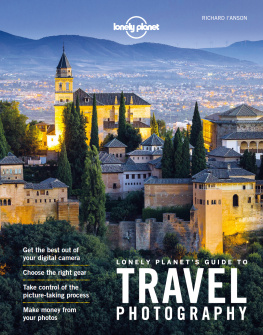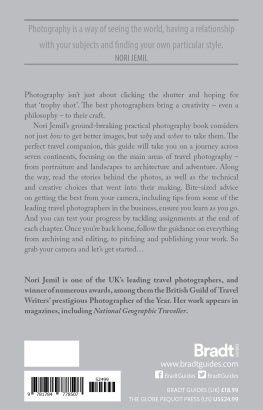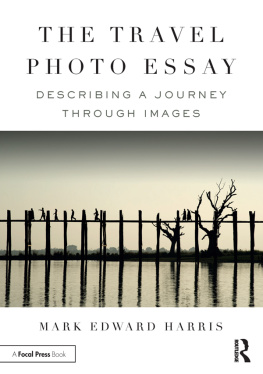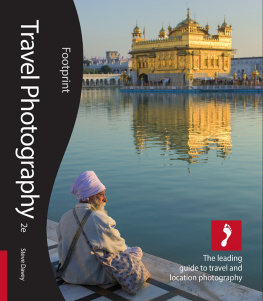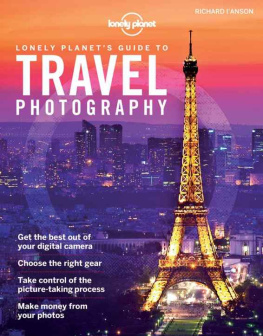
CONTENTS

TRAVEL PHOTOGRAPHY
5th edition July 2016
ISBN 978 1 76034 183 1
PUBLISHED BY
Lonely Planet Publications Pty Ltd
ABN 36 005 607 983
LONELY PLANET OFFICES
240 Blackfriars Rd, London SE1 8NW, UK
Level 2 & 3, 551 Swanston St, Carlton, Victoria 3053, Australia
230 Franklin Rd, Building 2B, Franklin, TN 37064, USA
PHOTOGRAPHS
Cover Image: The Alhambra, Granada, Spain
Title Page Images:
Light trails & Suleymaniye Mosque, Istanbul, Turkey
Paint runs on desk, Injalak Arts, Gunbalanya, Australia
Village elder at festival, Karsha, Zanskar, India
Hot-air balloon, Amber, India
Many of the images in this guide are available for licensing from Getty Images (www.gettyimages.com).
Text & photographs Richard IAnson 2016
All rights reserved. No part of this publication may be copied, stored in a retrieval system, or transmitted in any form by any means, electronic, mechanical, recording or otherwise, except brief extracts for the purpose of review, and no part of this publication may be sold or hired, without the written permission of the publisher.
Lonely Planet and the Lonely Planet logo are trademarks of Lonely Planet and are registered in the US Patent and Trademark Office and in other countries.
Lonely Planet does not allow its name or logo to be appropriated by commercial establishments, such as retailers, restaurants or hotels.
Please let us know of any misuses: www.lonelyplanet.com/ip.
THE AUTHOR

Richard IAnson is a freelance photographer who has built a career on his twin passions for travel and photography. Over the past 34 years he has travelled the world amassing a substantial and compelling collection of images of people and places in more than 90 countries on all seven continents.
Richard received his first camera as a gift from his parents when he was 16 and has been infatuated with photography ever since. After studying photography, film and television for two years at Rusden State College in Melbourne, he worked in a camera store and minilab before going freelance in 1982.
His work is published worldwide in books, magazines, newspapers, brochures, calendars, posters, cards and websites. He has published numerous books: Chasing Rickshaws (1998) and Rice Trails (2004), both collaborations with Lonely Planet co-founder Tony Wheeler; Lonely Planets Guide to Travel Photography (2000, 2004, 2009 and 2012 editions); Urban Travel Photography (2006); Lonely Planets Best Ever Photography Tips (2013); and the large-format pictorials Australia: 42 Great Landscape Experiences (2006), Nepal: Kathmandu Valley, Chitwan, Annapurna, Mustang, Everest (2007) and India: Essential Encounters (2010).
Richard is a Master of Photography with the Australian Institute of Professional Photography (AIPP), was judged top travel photographer in Capture Magazines 2007 Australias Top Photographers Awards and represents Canon Australia as a Canon Master Photographer. He was one of five photographers selected for the National Geographic Channel television series Tales by Light (screened in Australia and New Zealand in 2015). Also in 2015 he was appointed as the World Nomads Travel Photography Scholarship mentor.
Richard runs workshops teaching all aspects of travel photography for individuals and small groups and leads photography tours to Australian and international destinations. He is also much sought after as a speaker and judge for photography and travel industry events and competitions.
Lonely Planet has been using Richards photographs for 25 years and his work has been featured in over 600 editions of Lonely Planet titles. When hes not on the road Richard lives in Sydney, Australia. To see more of Richards images log onto www.richardianson.com, www.facebook.com/richardiansonphotography and follow him on instagram @richianson.
FROM THE AUTHOR
Its a pleasure to be able to share what Ive learned and seen in more than 34 years of shooting travel photographs. Thanks to the rapidly evolving developments in the world of digital photography, its a serious challenge for all of us involved in the imaging industry to keep up to date with equipment and software offerings. Writing this book gives me the opportunity to gather, assess and present a relevant snapshot of this information alongside the more creative and timeless elements of the art, subjects and practicalities of travel photography.
Its also a great opportunity to thank again the people who have played a significant part in my journey and contributed in various ways to my body of work from which I draw the contents of this book. Thanks then to Tony and Maureen Wheeler (Lonely Planets founders), Nick Kostos and Sue Badyari at World Expeditions, the teams at Canon Australia and Canon Professional Services, Abraham Joffe at Untitled Film Works, Charles Carlow and Emma Pritchett at Wild Bush Luxury and Alicia Crosariol and Pari Bilimoria at World Nomads.
THIS BOOK

USING THIS BOOK
Travel is an exciting experience and your photography should reflect that. Lonely Planets Guide to Travel Photography introduces you to every aspect of the picture-taking process and the wide range of subject matter that youll encounter on your travels, to help you produce vibrant and meaningful images. It aims to increase the percentage of good photographs you take and to lift your travel photography to the next level of creativity. No matter where youre going or what camera you use, youll find the information you need to make the most of the picture-taking situations that come your way. It will help you create photographic opportunities and to make your travel experience more photo friendly, with practical advice, tried-and-tested tips and inspirational images sure to get you thinking about both your photography and your next trip.
With film cameras no longer being manufactured, every new camera these days is a digital model. Although film still has a loyal following, the book assumes readers will be travelling with a digital camera. And although there is a substantial amount of technical information, the heart of the book lies in the images.
Although the focus of the book is on capturing great still images on digital cameras, digital technology has opened up other possibilities for recording images. In the (not so) old days, you needed a camera for taking photos, a phone for making phone calls, an MP3 player for listening to music and a video camera for taking videos. Now you can do all of these things on one device. This is called technology convergence and it is leading to some truly exciting innovations. The most relevant examples to image-making are the camera phone, allowing both still and video images to be captured on a device made for making phone calls; video-capture mode on digital still cameras; and still-capture mode on video cameras. The introduction of video mode on digital cameras and mobile phones has introduced many people to the world of video-making for the first time. This book follows the convergence trend and offers advice about making photographs and videos with camera phones and digital cameras.
Next page
